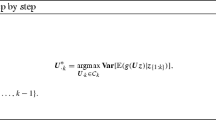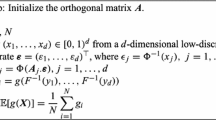Abstract
Effective dimension, an indicator for the difficulty of high-dimensional integration, describes whether a function can be well approximated by low-dimensional terms or sums of low-order terms. Some problems in option pricing are believed to have low effective dimensions, which help explain the success of quasi-Monte Carlo (QMC) methods recently observed in financial engineering. This paper provides a way of studying the structure of effective dimensions by finding a proper space the function of interest belongs to and then determining the effective dimension of that space. To this end, we extend the definitions of effective dimensions to weighted function spaces with product-order-dependent weights and give bounds on norms and variances. Furthermore, we show that the proposed method is applicable to functions arising in option pricing and consequently offers some hints on the performance of QMC methods.
Similar content being viewed by others
References
Bohn B, Griebel M (2013) An adaptive sparse grid approach for time series prediction, sparse grids and applications. Springer, Berlin
Caflisch RE, Morokoff W, Owen A (1997) Valuation of mortgage backed securities using Brownian bridges to reduce effective dimension. J Comput Finance 1:27–46
Dick J, Gnewuch M (2014) Optimal randomized changing dimension algorithms for infinite-dimensional integration on function spaces with ANOVA-type decomposition. J Approx Theory 184:111–145
Dick J, Pillichshammer F (2010) Digital nets and sequences: discrepancy theory and quasi-Monte Carlo integration. Cambridge University Press, Cambridge
Dick J, Sloan IH, Wang X, Woźniakowski H (2006) Good lattice rules in weighted Korobov spaces with general weights. Numer Math 103:63–97
Dick J, Kuo FY, Sloan IH (2013) High-dimensional integration: the quasi-Monte Carlo way. Acta Numer 22:133–288
Hull J (1999) Options, futures, and other derivatives. Pearson Education, Noida
Imai J, Tan KS (2014) Pricing derivative securities using integrated quasi-Monte Carlo methods with dimension reduction and discontinuity realignment. SIAM J Sci Comput 36:A2101–A2121
Joy C, Boyle PP, Tan KS (1996) Quasi-Monte Carlo methods in numerical finance. Manag Sci 42:926–938
Kuo FY, Schwab C, Sloan IH (2012) Quasi-Monte Carlo finite element methods for a class of elliptic partial differential equations with random coefficients. SIAM J Numer Anal 50:3351–3374
Kuo FY, Schwab C, Sloan IH (2012) Quasi-Monte Carlo methods for high-dimensional integration: the standard (weighted Hilbert space) setting and beyond. ANZIAM J 53:1–37
Kuo FY, Schwab C, Sloan IH (2015) Multi-level quasi-Monte Carlo finite element methods for a class of elliptic partial differential equations with random coefficients. Found Comput Math 15:411–449
Lemieux C (2009) Monte Carlo and quasi-Monte Carlo sampling. Springer, Berlin
Niederreiter H (1992) Random number generation and quasi-Monte Carlo methods. SIAM, Philadelphia
Owen A (2014) Effective dimension for weighted function spaces. Unpublished results. Stanford University, Stanford
Paskov SH, Traub JF (1995) Faster valuation of financial derivatives. J Portf Manag 22:113–123
Sharkey T (2011) Infinite linear programs. Wiley Encyclopedia of Operations Research and Management Science, New Jersey
Shen J, Wang L (2010) Sparse spectral approximations of high-dimensional problems based on hyperbolic cross. SIAM J Numer Anal 48:1087–1109
Sloan IH, Woźniakowski H (1998) When are quasi-Monte Carlo algorithms efficient for high dimensional integrals? J Complex 14:1–33
Sobol IM (2001) Global sensitivity indices for nonlinear mathematical models and their Monte Carlo estimates. Math Comput Simul 55:271–280
Wang X (2012) Enhancing quasi-Monte Carlo Methods by Exploiting Additive Approximation for Problems in Finance. SIAM J Sci Comput 34:A283–A308
Wang X, Fang KT (2003) The effective dimension and quasi-Monte Carlo integration. J Complex 19:101–124
Wang X, Sloan IH (2005) Why are high-dimensional finance problems often of low effective dimension? SIAM J Sci Comput 27:159–183
Wang X, Sloan IH (2007) Brownian bridge and principal component analysis: towards removing the curse of dimensionality. IMA J Numer Anal 27:631–654
Wang X, Tan KS (2013) Pricing and hedging with discontinuous functions: quasi-Monte Carlo methods and dimension reduction. Manag Sci 59:376–389
Author information
Authors and Affiliations
Corresponding author
Ethics declarations
Conflict of interest
The authors declare that there is no conflict of interests regarding the publication of this paper.
Rights and permissions
About this article
Cite this article
Fan, C., Wu, Q. & Khan, Y. A new method to explore the structure of effective dimensions for functions. Neural Comput & Applic 30, 2479–2487 (2018). https://doi.org/10.1007/s00521-016-2814-6
Received:
Accepted:
Published:
Issue Date:
DOI: https://doi.org/10.1007/s00521-016-2814-6




